Literature Review: The Transformative Impact of E-commerce on Retail
VerifiedAdded on 2021/01/03
|8
|2504
|64
Literature Review
AI Summary
This literature review examines the significant impact of e-commerce on the retail industry. It explores how technology and smartphones have transformed business operations, leading to a surge in online shopping and a decline in physical retail sales. The review discusses the changing consumer behavior, the rise of e-commerce companies, and the challenges faced by traditional retailers. It highlights the benefits of e-commerce, such as increased product variety, convenience, and cost savings, while also addressing the negative impacts on small retailers and the changing customer experience. The review synthesizes the findings of various studies and journal articles, concluding that e-commerce has fundamentally altered the retail landscape, with a shift towards online platforms and a need for businesses to adapt to survive in the competitive market. The future trends also suggest that e-commerce will continue to grow and will contribute significantly to the retail sector's overall sales, with a potential for increased competition and innovation in the industry.
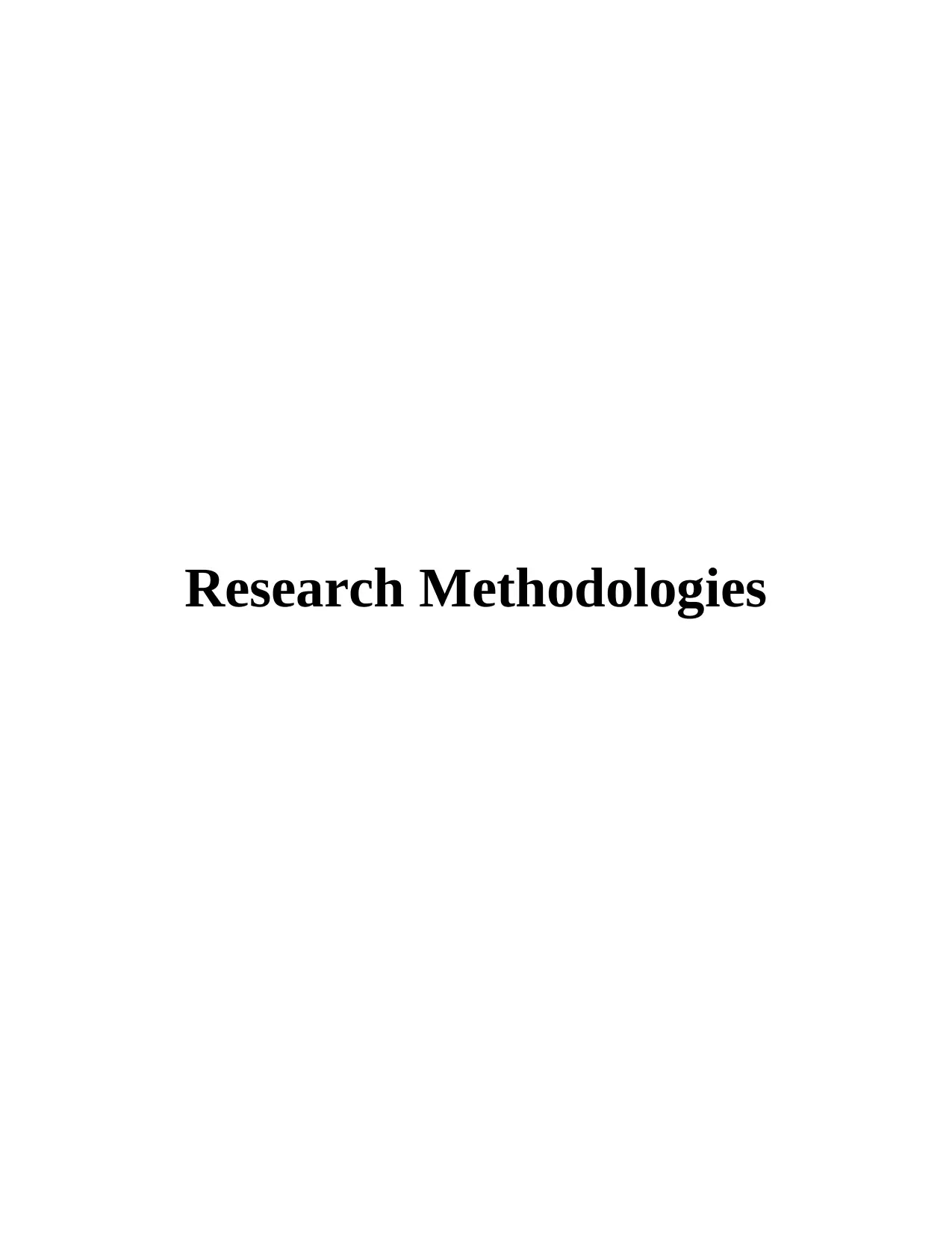
Research Methodologies
Paraphrase This Document
Need a fresh take? Get an instant paraphrase of this document with our AI Paraphraser
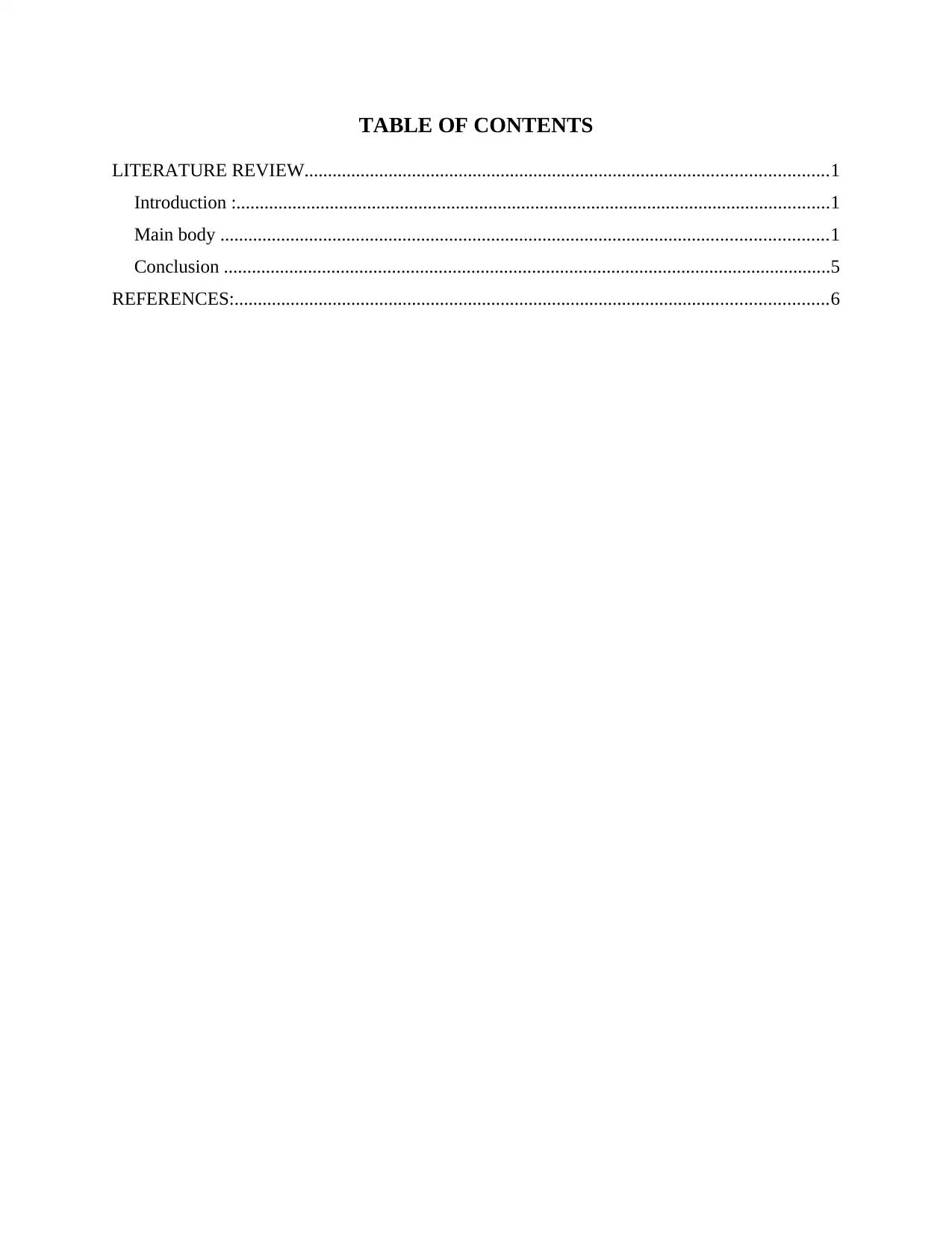
TABLE OF CONTENTS
LITERATURE REVIEW................................................................................................................1
Introduction :...............................................................................................................................1
Main body ..................................................................................................................................1
Conclusion ..................................................................................................................................5
REFERENCES:...............................................................................................................................6
LITERATURE REVIEW................................................................................................................1
Introduction :...............................................................................................................................1
Main body ..................................................................................................................................1
Conclusion ..................................................................................................................................5
REFERENCES:...............................................................................................................................6
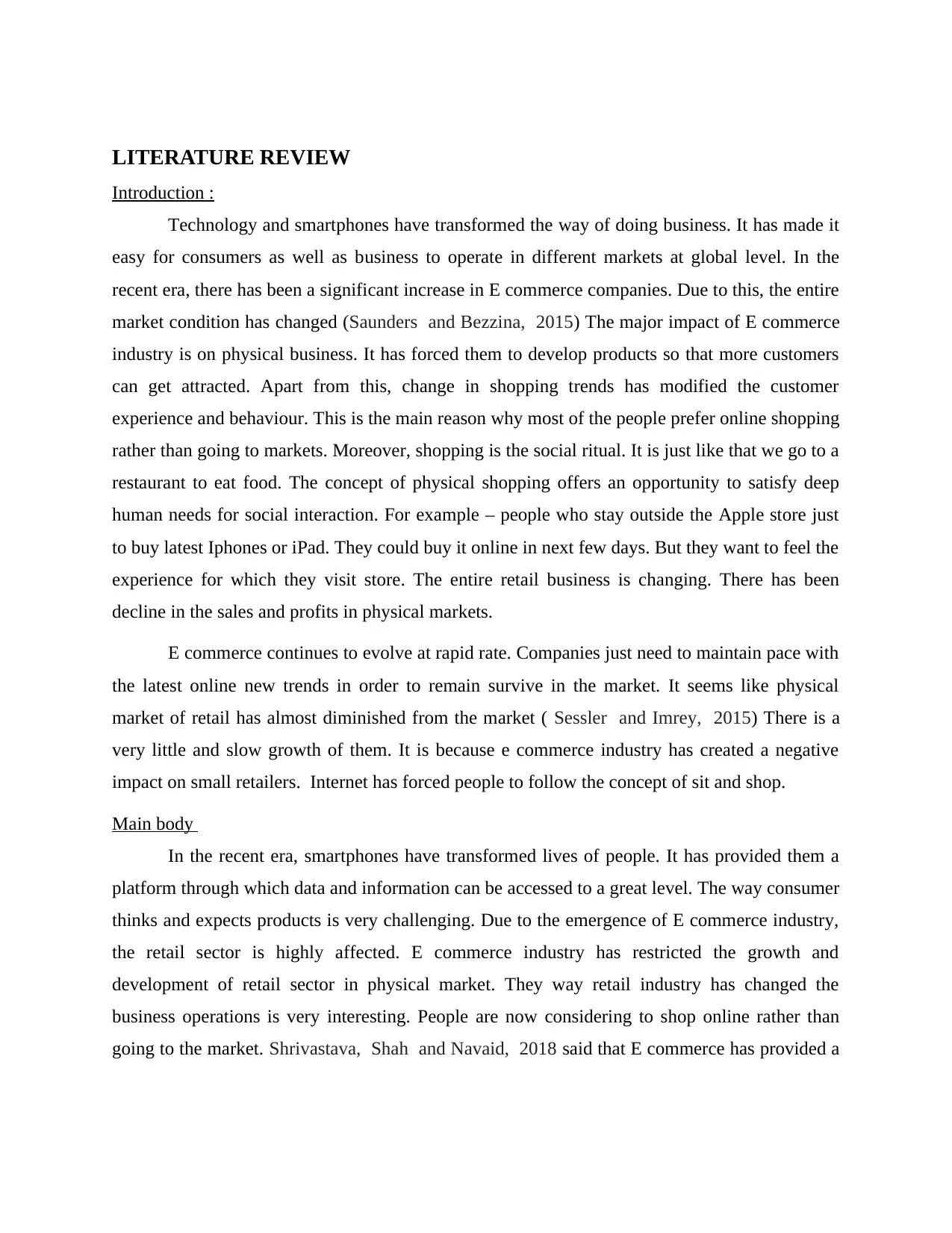
LITERATURE REVIEW
Introduction :
Technology and smartphones have transformed the way of doing business. It has made it
easy for consumers as well as business to operate in different markets at global level. In the
recent era, there has been a significant increase in E commerce companies. Due to this, the entire
market condition has changed (Saunders and Bezzina, 2015) The major impact of E commerce
industry is on physical business. It has forced them to develop products so that more customers
can get attracted. Apart from this, change in shopping trends has modified the customer
experience and behaviour. This is the main reason why most of the people prefer online shopping
rather than going to markets. Moreover, shopping is the social ritual. It is just like that we go to a
restaurant to eat food. The concept of physical shopping offers an opportunity to satisfy deep
human needs for social interaction. For example – people who stay outside the Apple store just
to buy latest Iphones or iPad. They could buy it online in next few days. But they want to feel the
experience for which they visit store. The entire retail business is changing. There has been
decline in the sales and profits in physical markets.
E commerce continues to evolve at rapid rate. Companies just need to maintain pace with
the latest online new trends in order to remain survive in the market. It seems like physical
market of retail has almost diminished from the market ( Sessler and Imrey, 2015) There is a
very little and slow growth of them. It is because e commerce industry has created a negative
impact on small retailers. Internet has forced people to follow the concept of sit and shop.
Main body
In the recent era, smartphones have transformed lives of people. It has provided them a
platform through which data and information can be accessed to a great level. The way consumer
thinks and expects products is very challenging. Due to the emergence of E commerce industry,
the retail sector is highly affected. E commerce industry has restricted the growth and
development of retail sector in physical market. They way retail industry has changed the
business operations is very interesting. People are now considering to shop online rather than
going to the market. Shrivastava, Shah and Navaid, 2018 said that E commerce has provided a
Introduction :
Technology and smartphones have transformed the way of doing business. It has made it
easy for consumers as well as business to operate in different markets at global level. In the
recent era, there has been a significant increase in E commerce companies. Due to this, the entire
market condition has changed (Saunders and Bezzina, 2015) The major impact of E commerce
industry is on physical business. It has forced them to develop products so that more customers
can get attracted. Apart from this, change in shopping trends has modified the customer
experience and behaviour. This is the main reason why most of the people prefer online shopping
rather than going to markets. Moreover, shopping is the social ritual. It is just like that we go to a
restaurant to eat food. The concept of physical shopping offers an opportunity to satisfy deep
human needs for social interaction. For example – people who stay outside the Apple store just
to buy latest Iphones or iPad. They could buy it online in next few days. But they want to feel the
experience for which they visit store. The entire retail business is changing. There has been
decline in the sales and profits in physical markets.
E commerce continues to evolve at rapid rate. Companies just need to maintain pace with
the latest online new trends in order to remain survive in the market. It seems like physical
market of retail has almost diminished from the market ( Sessler and Imrey, 2015) There is a
very little and slow growth of them. It is because e commerce industry has created a negative
impact on small retailers. Internet has forced people to follow the concept of sit and shop.
Main body
In the recent era, smartphones have transformed lives of people. It has provided them a
platform through which data and information can be accessed to a great level. The way consumer
thinks and expects products is very challenging. Due to the emergence of E commerce industry,
the retail sector is highly affected. E commerce industry has restricted the growth and
development of retail sector in physical market. They way retail industry has changed the
business operations is very interesting. People are now considering to shop online rather than
going to the market. Shrivastava, Shah and Navaid, 2018 said that E commerce has provided a
⊘ This is a preview!⊘
Do you want full access?
Subscribe today to unlock all pages.

Trusted by 1+ million students worldwide
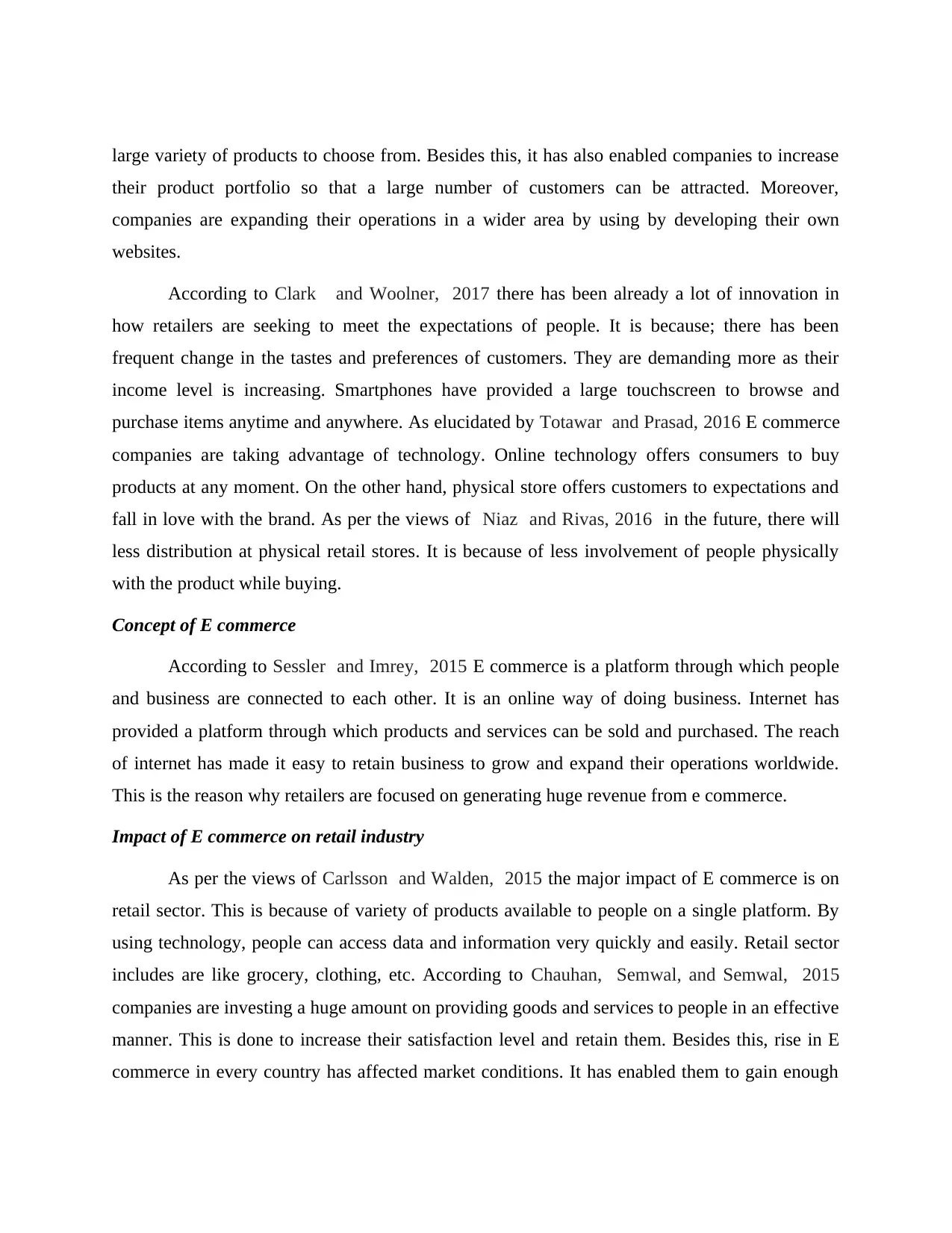
large variety of products to choose from. Besides this, it has also enabled companies to increase
their product portfolio so that a large number of customers can be attracted. Moreover,
companies are expanding their operations in a wider area by using by developing their own
websites.
According to Clark and Woolner, 2017 there has been already a lot of innovation in
how retailers are seeking to meet the expectations of people. It is because; there has been
frequent change in the tastes and preferences of customers. They are demanding more as their
income level is increasing. Smartphones have provided a large touchscreen to browse and
purchase items anytime and anywhere. As elucidated by Totawar and Prasad, 2016 E commerce
companies are taking advantage of technology. Online technology offers consumers to buy
products at any moment. On the other hand, physical store offers customers to expectations and
fall in love with the brand. As per the views of Niaz and Rivas, 2016 in the future, there will
less distribution at physical retail stores. It is because of less involvement of people physically
with the product while buying.
Concept of E commerce
According to Sessler and Imrey, 2015 E commerce is a platform through which people
and business are connected to each other. It is an online way of doing business. Internet has
provided a platform through which products and services can be sold and purchased. The reach
of internet has made it easy to retain business to grow and expand their operations worldwide.
This is the reason why retailers are focused on generating huge revenue from e commerce.
Impact of E commerce on retail industry
As per the views of Carlsson and Walden, 2015 the major impact of E commerce is on
retail sector. This is because of variety of products available to people on a single platform. By
using technology, people can access data and information very quickly and easily. Retail sector
includes are like grocery, clothing, etc. According to Chauhan, Semwal, and Semwal, 2015
companies are investing a huge amount on providing goods and services to people in an effective
manner. This is done to increase their satisfaction level and retain them. Besides this, rise in E
commerce in every country has affected market conditions. It has enabled them to gain enough
their product portfolio so that a large number of customers can be attracted. Moreover,
companies are expanding their operations in a wider area by using by developing their own
websites.
According to Clark and Woolner, 2017 there has been already a lot of innovation in
how retailers are seeking to meet the expectations of people. It is because; there has been
frequent change in the tastes and preferences of customers. They are demanding more as their
income level is increasing. Smartphones have provided a large touchscreen to browse and
purchase items anytime and anywhere. As elucidated by Totawar and Prasad, 2016 E commerce
companies are taking advantage of technology. Online technology offers consumers to buy
products at any moment. On the other hand, physical store offers customers to expectations and
fall in love with the brand. As per the views of Niaz and Rivas, 2016 in the future, there will
less distribution at physical retail stores. It is because of less involvement of people physically
with the product while buying.
Concept of E commerce
According to Sessler and Imrey, 2015 E commerce is a platform through which people
and business are connected to each other. It is an online way of doing business. Internet has
provided a platform through which products and services can be sold and purchased. The reach
of internet has made it easy to retain business to grow and expand their operations worldwide.
This is the reason why retailers are focused on generating huge revenue from e commerce.
Impact of E commerce on retail industry
As per the views of Carlsson and Walden, 2015 the major impact of E commerce is on
retail sector. This is because of variety of products available to people on a single platform. By
using technology, people can access data and information very quickly and easily. Retail sector
includes are like grocery, clothing, etc. According to Chauhan, Semwal, and Semwal, 2015
companies are investing a huge amount on providing goods and services to people in an effective
manner. This is done to increase their satisfaction level and retain them. Besides this, rise in E
commerce in every country has affected market conditions. It has enabled them to gain enough
Paraphrase This Document
Need a fresh take? Get an instant paraphrase of this document with our AI Paraphraser
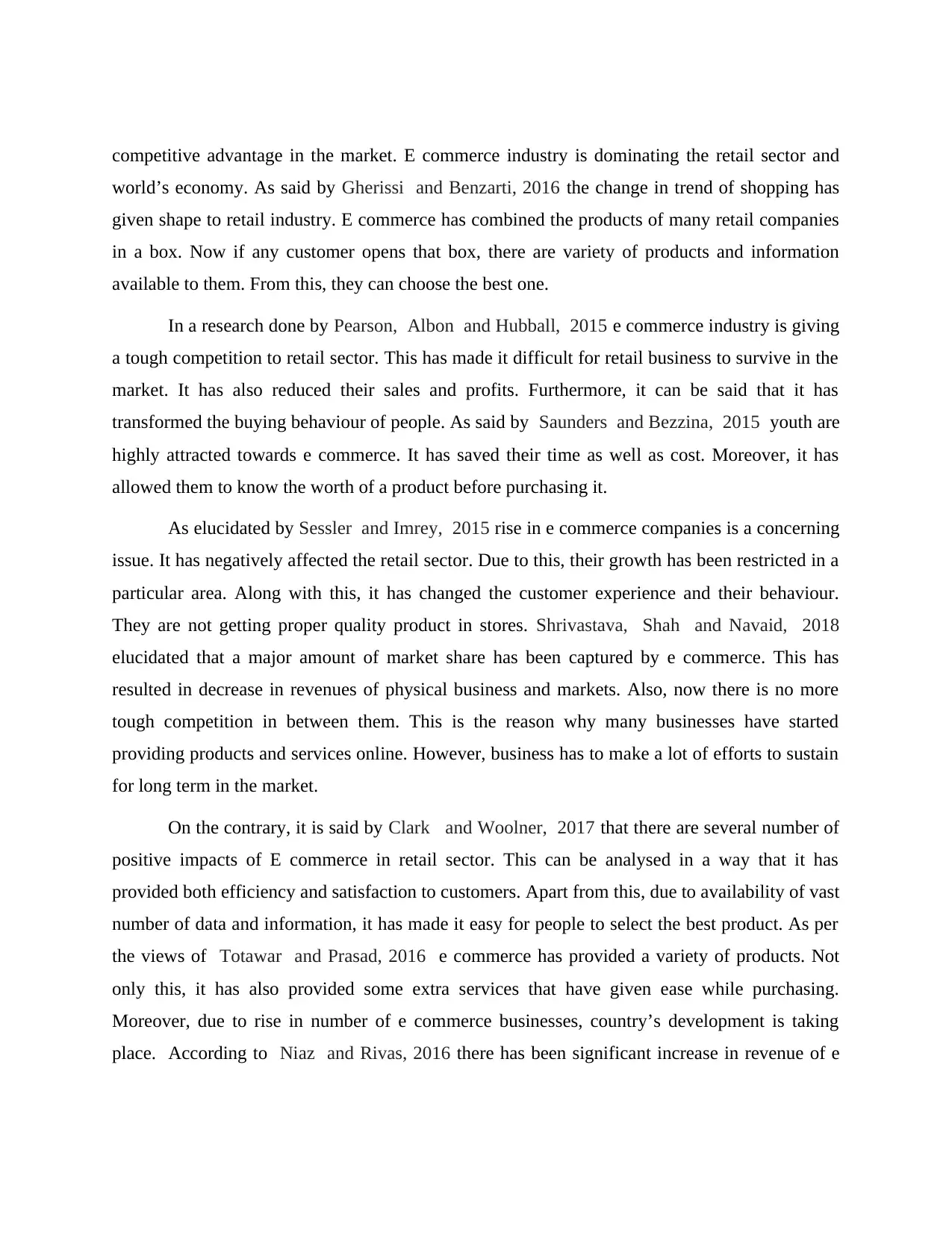
competitive advantage in the market. E commerce industry is dominating the retail sector and
world’s economy. As said by Gherissi and Benzarti, 2016 the change in trend of shopping has
given shape to retail industry. E commerce has combined the products of many retail companies
in a box. Now if any customer opens that box, there are variety of products and information
available to them. From this, they can choose the best one.
In a research done by Pearson, Albon and Hubball, 2015 e commerce industry is giving
a tough competition to retail sector. This has made it difficult for retail business to survive in the
market. It has also reduced their sales and profits. Furthermore, it can be said that it has
transformed the buying behaviour of people. As said by Saunders and Bezzina, 2015 youth are
highly attracted towards e commerce. It has saved their time as well as cost. Moreover, it has
allowed them to know the worth of a product before purchasing it.
As elucidated by Sessler and Imrey, 2015 rise in e commerce companies is a concerning
issue. It has negatively affected the retail sector. Due to this, their growth has been restricted in a
particular area. Along with this, it has changed the customer experience and their behaviour.
They are not getting proper quality product in stores. Shrivastava, Shah and Navaid, 2018
elucidated that a major amount of market share has been captured by e commerce. This has
resulted in decrease in revenues of physical business and markets. Also, now there is no more
tough competition in between them. This is the reason why many businesses have started
providing products and services online. However, business has to make a lot of efforts to sustain
for long term in the market.
On the contrary, it is said by Clark and Woolner, 2017 that there are several number of
positive impacts of E commerce in retail sector. This can be analysed in a way that it has
provided both efficiency and satisfaction to customers. Apart from this, due to availability of vast
number of data and information, it has made it easy for people to select the best product. As per
the views of Totawar and Prasad, 2016 e commerce has provided a variety of products. Not
only this, it has also provided some extra services that have given ease while purchasing.
Moreover, due to rise in number of e commerce businesses, country’s development is taking
place. According to Niaz and Rivas, 2016 there has been significant increase in revenue of e
world’s economy. As said by Gherissi and Benzarti, 2016 the change in trend of shopping has
given shape to retail industry. E commerce has combined the products of many retail companies
in a box. Now if any customer opens that box, there are variety of products and information
available to them. From this, they can choose the best one.
In a research done by Pearson, Albon and Hubball, 2015 e commerce industry is giving
a tough competition to retail sector. This has made it difficult for retail business to survive in the
market. It has also reduced their sales and profits. Furthermore, it can be said that it has
transformed the buying behaviour of people. As said by Saunders and Bezzina, 2015 youth are
highly attracted towards e commerce. It has saved their time as well as cost. Moreover, it has
allowed them to know the worth of a product before purchasing it.
As elucidated by Sessler and Imrey, 2015 rise in e commerce companies is a concerning
issue. It has negatively affected the retail sector. Due to this, their growth has been restricted in a
particular area. Along with this, it has changed the customer experience and their behaviour.
They are not getting proper quality product in stores. Shrivastava, Shah and Navaid, 2018
elucidated that a major amount of market share has been captured by e commerce. This has
resulted in decrease in revenues of physical business and markets. Also, now there is no more
tough competition in between them. This is the reason why many businesses have started
providing products and services online. However, business has to make a lot of efforts to sustain
for long term in the market.
On the contrary, it is said by Clark and Woolner, 2017 that there are several number of
positive impacts of E commerce in retail sector. This can be analysed in a way that it has
provided both efficiency and satisfaction to customers. Apart from this, due to availability of vast
number of data and information, it has made it easy for people to select the best product. As per
the views of Totawar and Prasad, 2016 e commerce has provided a variety of products. Not
only this, it has also provided some extra services that have given ease while purchasing.
Moreover, due to rise in number of e commerce businesses, country’s development is taking
place. According to Niaz and Rivas, 2016 there has been significant increase in revenue of e
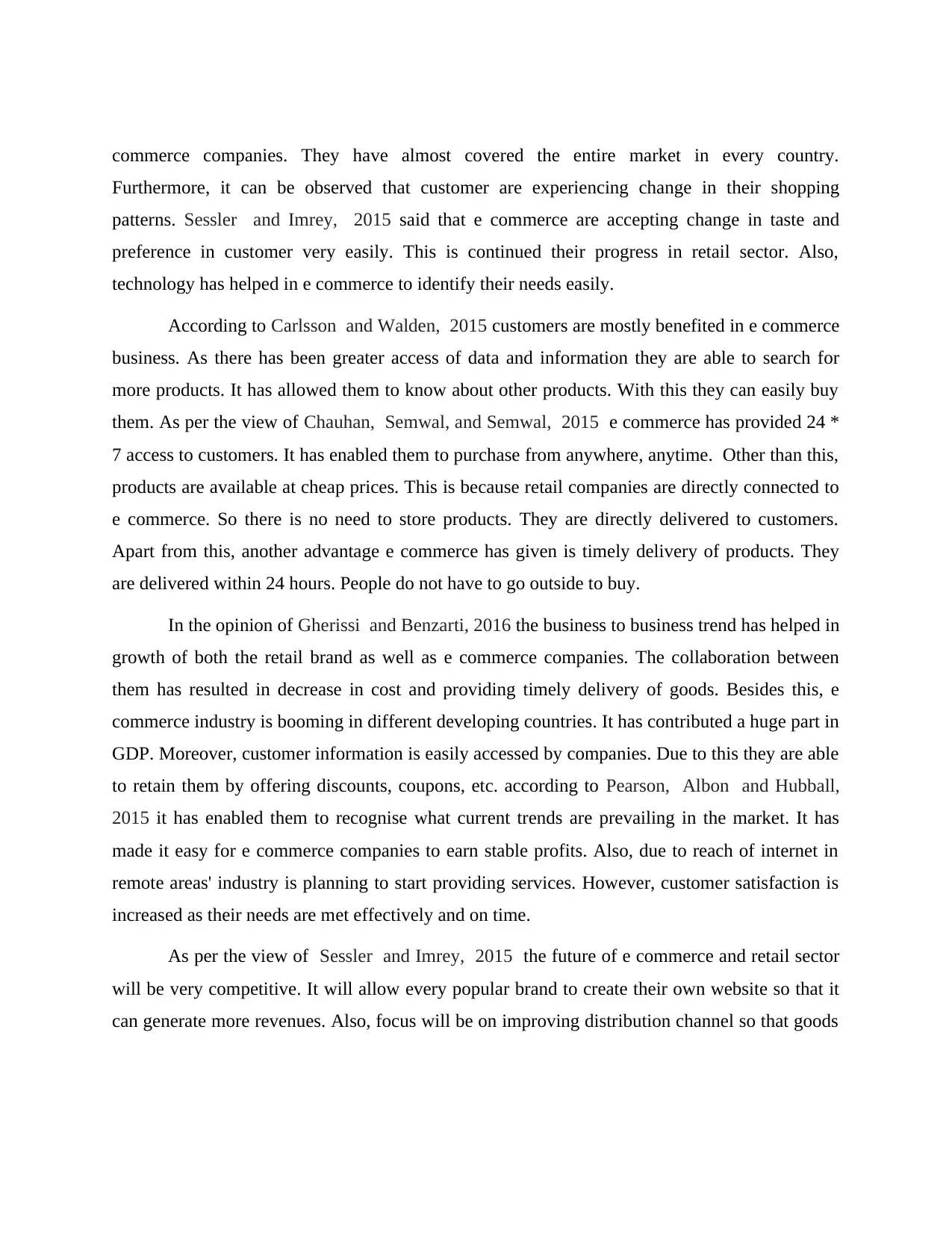
commerce companies. They have almost covered the entire market in every country.
Furthermore, it can be observed that customer are experiencing change in their shopping
patterns. Sessler and Imrey, 2015 said that e commerce are accepting change in taste and
preference in customer very easily. This is continued their progress in retail sector. Also,
technology has helped in e commerce to identify their needs easily.
According to Carlsson and Walden, 2015 customers are mostly benefited in e commerce
business. As there has been greater access of data and information they are able to search for
more products. It has allowed them to know about other products. With this they can easily buy
them. As per the view of Chauhan, Semwal, and Semwal, 2015 e commerce has provided 24 *
7 access to customers. It has enabled them to purchase from anywhere, anytime. Other than this,
products are available at cheap prices. This is because retail companies are directly connected to
e commerce. So there is no need to store products. They are directly delivered to customers.
Apart from this, another advantage e commerce has given is timely delivery of products. They
are delivered within 24 hours. People do not have to go outside to buy.
In the opinion of Gherissi and Benzarti, 2016 the business to business trend has helped in
growth of both the retail brand as well as e commerce companies. The collaboration between
them has resulted in decrease in cost and providing timely delivery of goods. Besides this, e
commerce industry is booming in different developing countries. It has contributed a huge part in
GDP. Moreover, customer information is easily accessed by companies. Due to this they are able
to retain them by offering discounts, coupons, etc. according to Pearson, Albon and Hubball,
2015 it has enabled them to recognise what current trends are prevailing in the market. It has
made it easy for e commerce companies to earn stable profits. Also, due to reach of internet in
remote areas' industry is planning to start providing services. However, customer satisfaction is
increased as their needs are met effectively and on time.
As per the view of Sessler and Imrey, 2015 the future of e commerce and retail sector
will be very competitive. It will allow every popular brand to create their own website so that it
can generate more revenues. Also, focus will be on improving distribution channel so that goods
Furthermore, it can be observed that customer are experiencing change in their shopping
patterns. Sessler and Imrey, 2015 said that e commerce are accepting change in taste and
preference in customer very easily. This is continued their progress in retail sector. Also,
technology has helped in e commerce to identify their needs easily.
According to Carlsson and Walden, 2015 customers are mostly benefited in e commerce
business. As there has been greater access of data and information they are able to search for
more products. It has allowed them to know about other products. With this they can easily buy
them. As per the view of Chauhan, Semwal, and Semwal, 2015 e commerce has provided 24 *
7 access to customers. It has enabled them to purchase from anywhere, anytime. Other than this,
products are available at cheap prices. This is because retail companies are directly connected to
e commerce. So there is no need to store products. They are directly delivered to customers.
Apart from this, another advantage e commerce has given is timely delivery of products. They
are delivered within 24 hours. People do not have to go outside to buy.
In the opinion of Gherissi and Benzarti, 2016 the business to business trend has helped in
growth of both the retail brand as well as e commerce companies. The collaboration between
them has resulted in decrease in cost and providing timely delivery of goods. Besides this, e
commerce industry is booming in different developing countries. It has contributed a huge part in
GDP. Moreover, customer information is easily accessed by companies. Due to this they are able
to retain them by offering discounts, coupons, etc. according to Pearson, Albon and Hubball,
2015 it has enabled them to recognise what current trends are prevailing in the market. It has
made it easy for e commerce companies to earn stable profits. Also, due to reach of internet in
remote areas' industry is planning to start providing services. However, customer satisfaction is
increased as their needs are met effectively and on time.
As per the view of Sessler and Imrey, 2015 the future of e commerce and retail sector
will be very competitive. It will allow every popular brand to create their own website so that it
can generate more revenues. Also, focus will be on improving distribution channel so that goods
⊘ This is a preview!⊘
Do you want full access?
Subscribe today to unlock all pages.

Trusted by 1+ million students worldwide
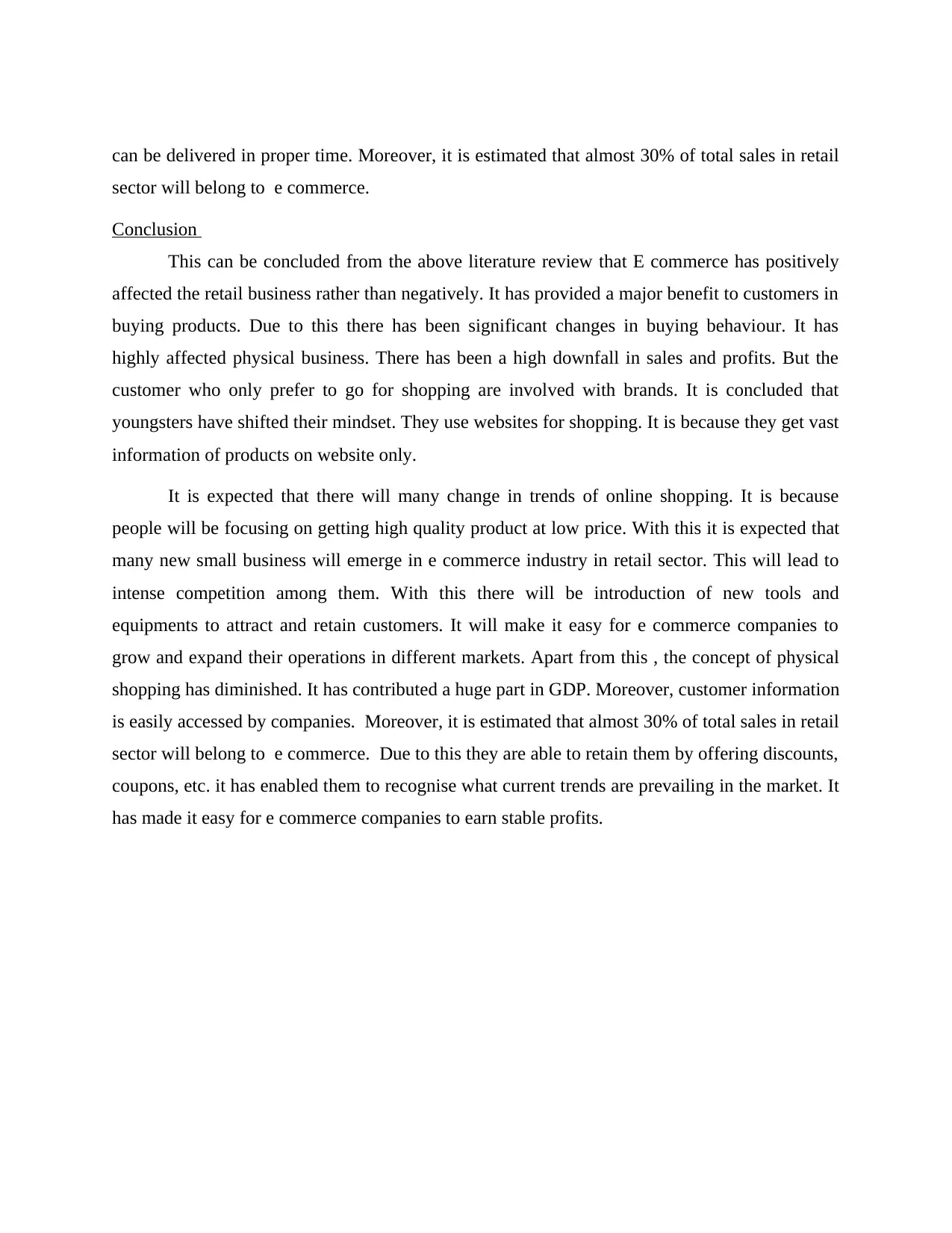
can be delivered in proper time. Moreover, it is estimated that almost 30% of total sales in retail
sector will belong to e commerce.
Conclusion
This can be concluded from the above literature review that E commerce has positively
affected the retail business rather than negatively. It has provided a major benefit to customers in
buying products. Due to this there has been significant changes in buying behaviour. It has
highly affected physical business. There has been a high downfall in sales and profits. But the
customer who only prefer to go for shopping are involved with brands. It is concluded that
youngsters have shifted their mindset. They use websites for shopping. It is because they get vast
information of products on website only.
It is expected that there will many change in trends of online shopping. It is because
people will be focusing on getting high quality product at low price. With this it is expected that
many new small business will emerge in e commerce industry in retail sector. This will lead to
intense competition among them. With this there will be introduction of new tools and
equipments to attract and retain customers. It will make it easy for e commerce companies to
grow and expand their operations in different markets. Apart from this , the concept of physical
shopping has diminished. It has contributed a huge part in GDP. Moreover, customer information
is easily accessed by companies. Moreover, it is estimated that almost 30% of total sales in retail
sector will belong to e commerce. Due to this they are able to retain them by offering discounts,
coupons, etc. it has enabled them to recognise what current trends are prevailing in the market. It
has made it easy for e commerce companies to earn stable profits.
sector will belong to e commerce.
Conclusion
This can be concluded from the above literature review that E commerce has positively
affected the retail business rather than negatively. It has provided a major benefit to customers in
buying products. Due to this there has been significant changes in buying behaviour. It has
highly affected physical business. There has been a high downfall in sales and profits. But the
customer who only prefer to go for shopping are involved with brands. It is concluded that
youngsters have shifted their mindset. They use websites for shopping. It is because they get vast
information of products on website only.
It is expected that there will many change in trends of online shopping. It is because
people will be focusing on getting high quality product at low price. With this it is expected that
many new small business will emerge in e commerce industry in retail sector. This will lead to
intense competition among them. With this there will be introduction of new tools and
equipments to attract and retain customers. It will make it easy for e commerce companies to
grow and expand their operations in different markets. Apart from this , the concept of physical
shopping has diminished. It has contributed a huge part in GDP. Moreover, customer information
is easily accessed by companies. Moreover, it is estimated that almost 30% of total sales in retail
sector will belong to e commerce. Due to this they are able to retain them by offering discounts,
coupons, etc. it has enabled them to recognise what current trends are prevailing in the market. It
has made it easy for e commerce companies to earn stable profits.
Paraphrase This Document
Need a fresh take? Get an instant paraphrase of this document with our AI Paraphraser
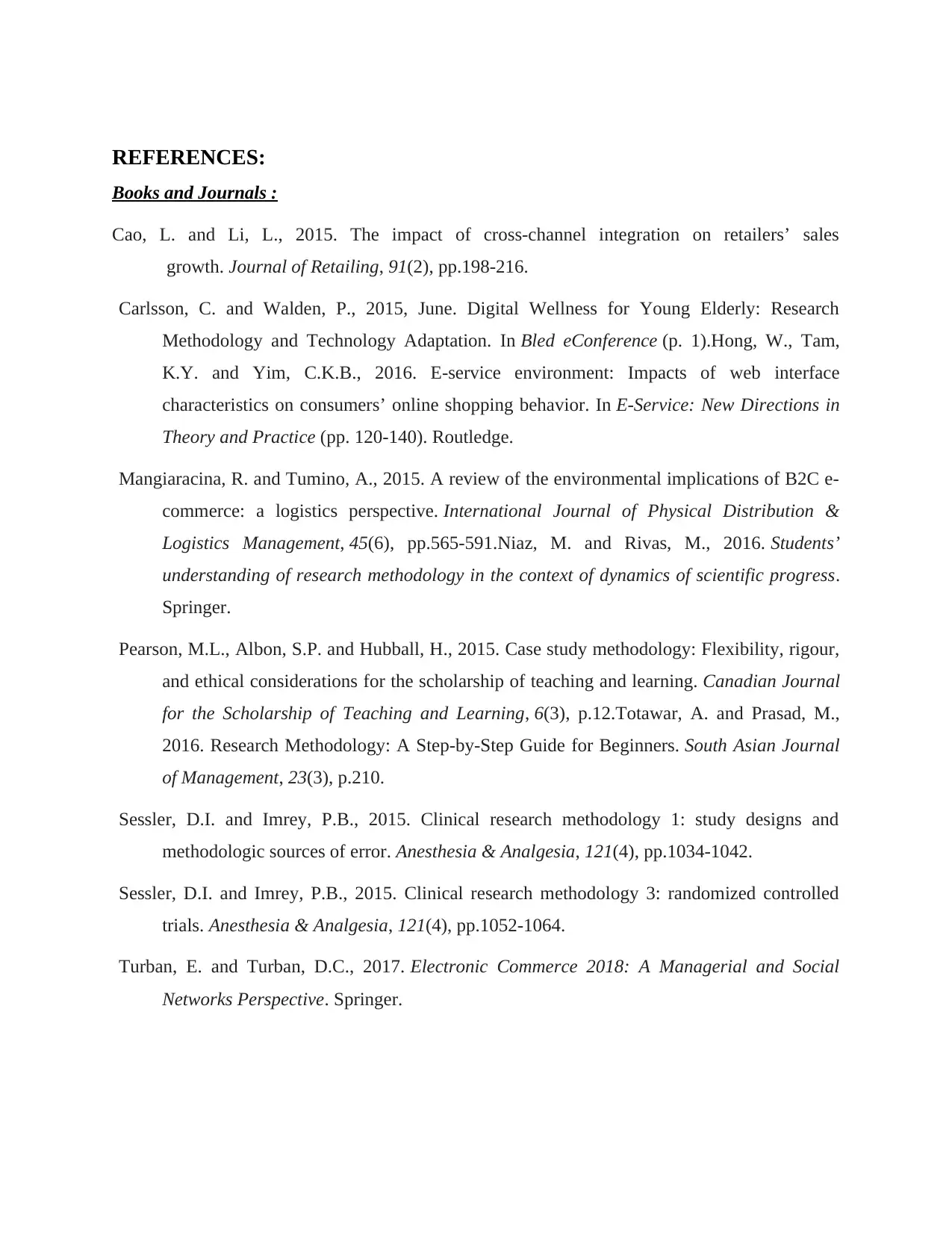
REFERENCES:
Books and Journals :
Cao, L. and Li, L., 2015. The impact of cross-channel integration on retailers’ sales
growth. Journal of Retailing, 91(2), pp.198-216.
Carlsson, C. and Walden, P., 2015, June. Digital Wellness for Young Elderly: Research
Methodology and Technology Adaptation. In Bled eConference (p. 1).Hong, W., Tam,
K.Y. and Yim, C.K.B., 2016. E-service environment: Impacts of web interface
characteristics on consumers’ online shopping behavior. In E-Service: New Directions in
Theory and Practice (pp. 120-140). Routledge.
Mangiaracina, R. and Tumino, A., 2015. A review of the environmental implications of B2C e-
commerce: a logistics perspective. International Journal of Physical Distribution &
Logistics Management, 45(6), pp.565-591.Niaz, M. and Rivas, M., 2016. Students’
understanding of research methodology in the context of dynamics of scientific progress.
Springer.
Pearson, M.L., Albon, S.P. and Hubball, H., 2015. Case study methodology: Flexibility, rigour,
and ethical considerations for the scholarship of teaching and learning. Canadian Journal
for the Scholarship of Teaching and Learning, 6(3), p.12.Totawar, A. and Prasad, M.,
2016. Research Methodology: A Step-by-Step Guide for Beginners. South Asian Journal
of Management, 23(3), p.210.
Sessler, D.I. and Imrey, P.B., 2015. Clinical research methodology 1: study designs and
methodologic sources of error. Anesthesia & Analgesia, 121(4), pp.1034-1042.
Sessler, D.I. and Imrey, P.B., 2015. Clinical research methodology 3: randomized controlled
trials. Anesthesia & Analgesia, 121(4), pp.1052-1064.
Turban, E. and Turban, D.C., 2017. Electronic Commerce 2018: A Managerial and Social
Networks Perspective. Springer.
Books and Journals :
Cao, L. and Li, L., 2015. The impact of cross-channel integration on retailers’ sales
growth. Journal of Retailing, 91(2), pp.198-216.
Carlsson, C. and Walden, P., 2015, June. Digital Wellness for Young Elderly: Research
Methodology and Technology Adaptation. In Bled eConference (p. 1).Hong, W., Tam,
K.Y. and Yim, C.K.B., 2016. E-service environment: Impacts of web interface
characteristics on consumers’ online shopping behavior. In E-Service: New Directions in
Theory and Practice (pp. 120-140). Routledge.
Mangiaracina, R. and Tumino, A., 2015. A review of the environmental implications of B2C e-
commerce: a logistics perspective. International Journal of Physical Distribution &
Logistics Management, 45(6), pp.565-591.Niaz, M. and Rivas, M., 2016. Students’
understanding of research methodology in the context of dynamics of scientific progress.
Springer.
Pearson, M.L., Albon, S.P. and Hubball, H., 2015. Case study methodology: Flexibility, rigour,
and ethical considerations for the scholarship of teaching and learning. Canadian Journal
for the Scholarship of Teaching and Learning, 6(3), p.12.Totawar, A. and Prasad, M.,
2016. Research Methodology: A Step-by-Step Guide for Beginners. South Asian Journal
of Management, 23(3), p.210.
Sessler, D.I. and Imrey, P.B., 2015. Clinical research methodology 1: study designs and
methodologic sources of error. Anesthesia & Analgesia, 121(4), pp.1034-1042.
Sessler, D.I. and Imrey, P.B., 2015. Clinical research methodology 3: randomized controlled
trials. Anesthesia & Analgesia, 121(4), pp.1052-1064.
Turban, E. and Turban, D.C., 2017. Electronic Commerce 2018: A Managerial and Social
Networks Perspective. Springer.
1 out of 8
Related Documents
Your All-in-One AI-Powered Toolkit for Academic Success.
+13062052269
info@desklib.com
Available 24*7 on WhatsApp / Email
![[object Object]](/_next/static/media/star-bottom.7253800d.svg)
Unlock your academic potential
Copyright © 2020–2025 A2Z Services. All Rights Reserved. Developed and managed by ZUCOL.





